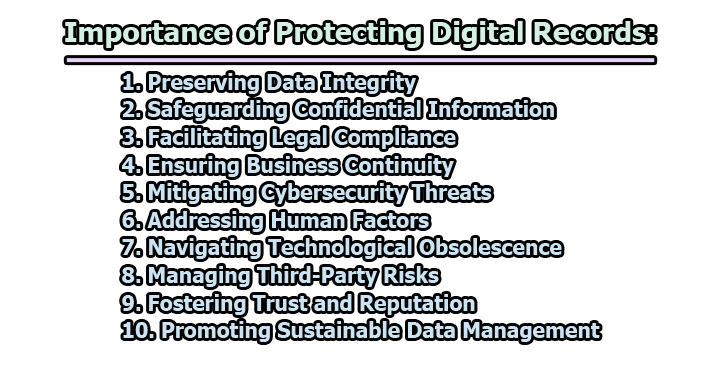Importance of Protecting Digital Records:
In the ever-evolving landscape of information management, the transition from traditional paper-based records to digital records has ushered in unparalleled convenience, efficiency, and accessibility. Digital records, stored in electronic formats, encompass a wide array of data types, ranging from text documents and images to databases and multimedia files. While the benefits of digital records are manifold, their importance is intricately tied to the imperative of ensuring robust protection. This article delves into the multifaceted importance of protecting digital records.
1. Preserving Data Integrity: Digital records are the lifeblood of contemporary information systems, playing a pivotal role in decision-making, historical documentation, and knowledge preservation. The integrity of these records is paramount for their trustworthiness and reliability. Unauthorized modifications, whether accidental or deliberate, can compromise the accuracy and authenticity of the information they contain.
Strategies for Preserving Data Integrity:
- Version Control: Implementing version control systems ensures that changes to digital records are tracked, documented, and reversible. This is crucial for maintaining a chronological history of modifications and reverting to previous states if necessary.
- Checksums and Hashing: Using cryptographic techniques such as checksums and hashing allows for the creation of unique identifiers (hash values) for digital records. Any alteration to the record, no matter how small, will result in a different hash value, providing a means to detect changes and potential tampering.
- Regular Audits and Validation: Periodic audits and validation processes can help identify discrepancies between expected and actual states of digital records. These checks can reveal anomalies early, allowing for timely corrective actions.
2. Safeguarding Confidential Information: Digital records often contain sensitive and confidential information, ranging from personal data in healthcare records to proprietary business strategies in corporate databases. Protecting this information is crucial not only for legal compliance but also for maintaining trust with individuals and stakeholders.
Strategies for Safeguarding Confidential Information:
- Encryption: Applying strong encryption algorithms to digital records ensures that even if unauthorized access occurs, the data remains unreadable without the appropriate decryption key.
- Access Controls: Implementing granular access controls ensures that only authorized personnel can view, edit, or delete specific digital records. Role-based access controls are effective in aligning access privileges with job responsibilities.
- Data Classification: Classifying digital records based on sensitivity levels allows organizations to tailor security measures according to the importance of the information. Critical records can receive heightened protection measures.
3. Facilitating Legal Compliance: Numerous industries operate within regulatory frameworks that mandate the secure handling of digital records. Compliance with these laws and regulations is not only ethically imperative but also a legal requirement. Failure to adhere to these standards can result in severe consequences, including fines and legal actions.
Strategies for Facilitating Legal Compliance:
- Data Governance Policies: Establishing comprehensive data governance policies that align with relevant regulations ensures a structured approach to data management. These policies should cover data access, storage, retention, and disposal.
- Regular Compliance Audits: Conducting regular audits to assess adherence to data protection laws and industry-specific regulations is essential. Audits identify areas of non-compliance, allowing organizations to rectify issues promptly.
- Data Protection Impact Assessments (DPIA): Conducting DPIAs helps organizations assess the potential risks and impacts of processing personal data. It is particularly useful when implementing new systems or processes that involve the handling of digital records.
4. Ensuring Business Continuity: Digital records are integral to the day-to-day operations of organizations. Protecting them against cyber threats, hardware failures, and natural disasters is crucial for ensuring business continuity. Loss or compromise of critical digital records can have severe consequences, disrupting operations and impacting organizational resilience.
Strategies for Ensuring Business Continuity:
- Robust Backup Strategies: Implementing regular and secure backup procedures ensures that copies of digital records are readily available in the event of data loss. Off-site backups add an extra layer of protection against on-site disasters.
- Disaster Recovery Plans: Developing comprehensive disaster recovery plans outlines the steps to be taken in the aftermath of a disruptive event. This includes the restoration of digital records and the resumption of normal business operations.
- Resilience Against Cyber Threats: Deploying advanced cybersecurity measures, such as intrusion detection systems, firewalls, and endpoint protection, helps safeguard digital records from malicious cyber activities that could compromise business continuity.
5. Mitigating Cybersecurity Threats: The digital realm is replete with cybersecurity threats, ranging from common phishing attacks to sophisticated ransomware incidents. Protecting digital records requires a proactive and multi-layered cybersecurity approach to safeguard against these evolving threats.
Strategies for Mitigating Cybersecurity Threats:
- Firewalls and Intrusion Detection Systems (IDS): Employing firewalls and IDS helps monitor and control network traffic, preventing unauthorized access and detecting potential cyber threats.
- Regular Security Audits: Conducting regular security audits allows organizations to identify vulnerabilities and weaknesses in their systems. This proactive approach enables the implementation of patches and updates to mitigate potential risks.
- User Education and Awareness: Human factors are often exploited in cyber attacks. Educating users about cybersecurity best practices, including recognizing phishing attempts and practicing good password hygiene, enhances the overall security posture.
6. Addressing Human Factors: Human errors, whether inadvertent or intentional, represent a significant challenge in maintaining the security of digital records. Individuals within an organization can be unintentionally careless, fall victim to social engineering attacks, or, in some cases, engage in malicious activities. Addressing these human factors is crucial for minimizing risks associated with internal threats.
Strategies for Addressing Human Factors:
- Education and Training Programs: Implementing comprehensive education and training programs on cybersecurity best practices helps raise awareness among employees. This includes guidance on recognizing phishing attempts, understanding the importance of strong password practices, and promoting a culture of security.
- User Authentication and Access Controls: Implementing strong user authentication mechanisms and access controls ensures that individuals only have access to the digital records necessary for their roles. This helps restrict the potential impact of human errors or malicious activities.
- Monitoring User Activity: Regularly monitoring user activity within digital record systems allows organizations to detect unusual patterns of behavior. Anomalies can be investigated promptly, mitigating potential risks arising from human factors.
7. Navigating Technological Obsolescence: The rapid pace of technological advancement introduces challenges related to the potential obsolescence of hardware, software, and file formats. Protecting digital records requires strategic planning to ensure continued accessibility and usability as technology evolves over time.
Strategies for Navigating Technological Obsolescence:
- Regular Technology Assessments: Conducting regular assessments of existing technologies helps organizations stay abreast of emerging trends and potential obsolescence risks. This includes evaluating hardware, software applications, and file formats.
- Data Migration Planning: Developing comprehensive plans for data migration ensures a smooth transition from outdated technologies to newer ones. This is critical for maintaining the integrity of digital records during technological upgrades.
- Adherence to Archival Best Practices: Following archival best practices involves adopting standardized formats for digital records and ensuring that data is stored in a manner that facilitates future migration and preservation efforts.
8. Managing Third-Party Risks: Many organizations leverage third-party services and cloud platforms for digital record storage and management. While these services offer scalability and convenience, they also introduce additional risks. Vigilant management of third-party risks is crucial to maintaining the security and integrity of digital records entrusted to external entities.
Strategies for Managing Third-Party Risks:
- Thorough Vendor Vetting: Conducting thorough assessments of third-party vendors, including their security practices and compliance with data protection standards, ensures that they meet the required security standards.
- Secure Data Transmission: Ensuring the secure transmission of data between the organization and third-party services minimizes the risk of interception or unauthorized access. This involves employing encryption for data in transit.
- Contractual Agreements: Establishing clear contractual agreements that outline data security requirements, confidentiality obligations, and compliance standards helps mitigate legal and security risks associated with third-party relationships.
9. Fostering Trust and Reputation: The protection of digital records is intricately linked to an organization’s reputation and the trust it engenders from clients, customers, and stakeholders. A breach of trust resulting from data breaches or mishandling of digital records can have profound and long-lasting consequences.
Strategies for Fostering Trust and Reputation:
- Transparent Communication: Transparent communication regarding data security measures and incidents, when necessary, builds trust. Organizations should communicate openly about their commitment to protecting digital records and addressing any security concerns.
- Demonstrating Compliance: Actively demonstrating compliance with relevant data protection regulations and industry standards provides assurance to stakeholders that the organization takes data security seriously.
- Investing in Cyber Insurance: Investing in cyber insurance can provide financial protection in the event of a data breach. This not only helps mitigate financial risks but also demonstrates a commitment to safeguarding digital records.
10. Promoting Sustainable Data Management: Digital records are not static entities; they represent valuable assets that contribute to organizational knowledge, innovation, and adaptability. Promoting sustainable data management involves strategies that go beyond immediate protection, fostering an environment where digital records can be leveraged for long-term organizational benefit.
Strategies for Promoting Sustainable Data Management:
- Innovation through Data Analysis: Leveraging digital records for data analysis and insights can drive innovation within an organization. This involves adopting technologies such as artificial intelligence and machine learning to derive value from the data.
- Historical Data Utilization: Recognizing the value of historical data and actively utilizing it for decision-making processes contributes to organizational resilience and adaptability. Digital records serve as a rich source of information that can inform future strategies.
- Adapting to Emerging Technologies: Being proactive in adopting emerging technologies ensures that digital records remain relevant and usable. This involves staying informed about technological trends and strategically integrating new technologies into existing data management practices.
In conclusion, the importance of protecting digital records is a multifaceted imperative that transcends mere cybersecurity concerns. It encompasses preserving data integrity, safeguarding confidentiality, ensuring legal compliance, and fostering a culture of trust and sustainability. The increasing reliance on digital records in the modern era necessitates a comprehensive approach to protection, embracing technological advancements, cybersecurity best practices, and proactive strategies to mitigate risks. As organizations navigate the complexities of an interconnected and data-centric world, the significance of protecting digital records becomes central to their resilience, reputation, and long-term success.

Former Student at Rajshahi University










